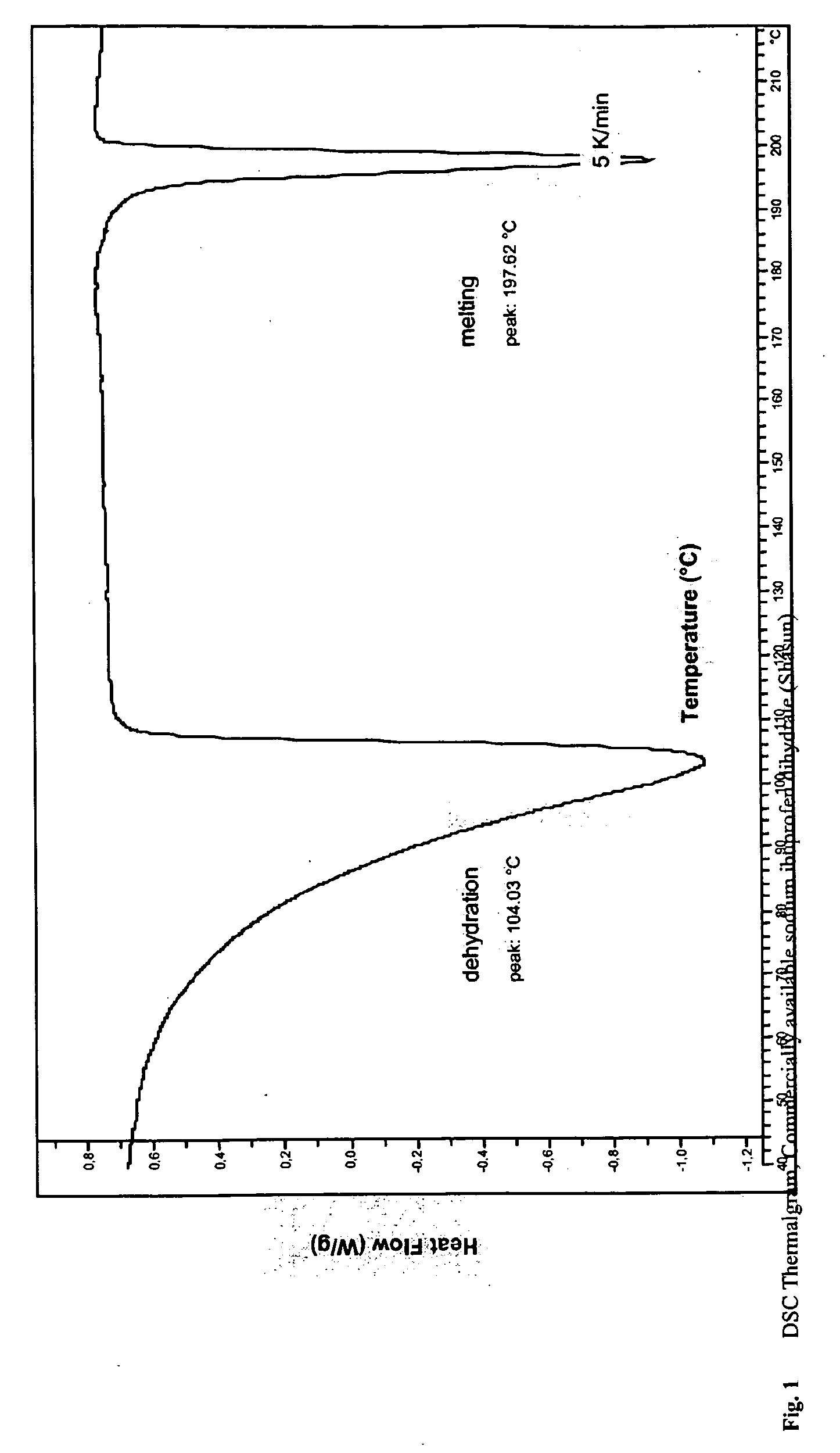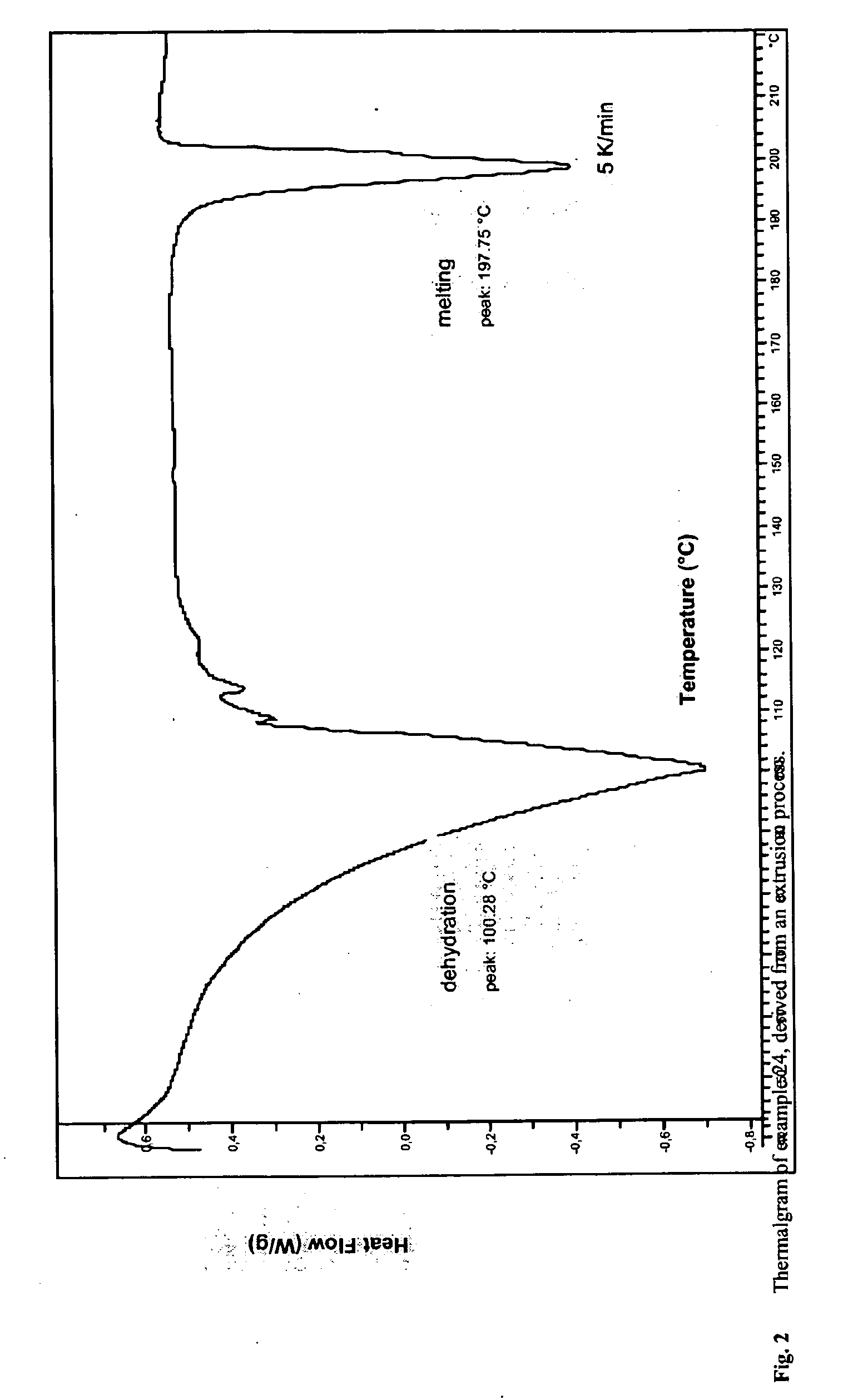Solubilized ibuprofen
a technology of ibuprofen and ibuprofen, which is applied in the preparation of carboxylic compounds, biocide, drug compositions, etc., can solve the problems of poor solubility of ibuprofen, high ph-dependent solubility, and large delay, so as to facilitate the production of granulates and improve the solubility. , the effect of rapid increase of blood level
- Summary
- Abstract
- Description
- Claims
- Application Information
AI Technical Summary
Benefits of technology
Problems solved by technology
Method used
Image
Examples
examples
[0130]The invention is further illustrated by the following examples. In the examples, Povidone®K17-K90 denote non-crosslinked polyvinylpyrrolidone and Aerosil denotes a silicon dioxide. Ibuprofen and the bases were utilized with the following particle sizes, except in Examples 29 and 36 where the reaction was carried out in an extruder and the particle sizes are thus unimportant: at least 95% of the ibuprofen particles had a particle size of less than 100 μm; at least 95% of the base particles had a particle size of less than 150 μm.
[0131]The tablet forms, manufactured according to the examples, can be coated, if desired, preferably with a sugar coating and / or film coating. As coating materials, generally all common types of sugars and film coating material are suitable. The amount of coating, related to the tablet cores, can vary from 15-50% for sugar coatings and generally from 1-10%, preferably from 2.5-5% for film coating.
examples 1-15
[0132]The examples summarized in Table 1 were carried out in a heatable and coolable mixing vessel.
TABLE 1Base(s) andProductExampleexcipient(s) a)Heating b)temp. c)Remarks d)10.95 mole NaOH,(ambient)81° C.highly exotherm; addition of 1 mole2.0% mannitolwater; granular powder, very weakcompressible21.0 mole Na2CO3,38° C.41° C.addition of 0.5 mole water before and0.4 mole KCl1.5 mole water after solubilization;8% Povidone K25granular powder, good compressible31.0 mole K2CO3,65° C.86° C.addition of 0.2 mole water hygroscopic,fine powder, extremely goodcompressible, extremely water soluble40.8 mole K2CO3,40° C.74° C.addition of 0.2 mole water; flowable0.3 mole NaOHgranules, very good compressible50.6 mole K2CO3,(ambient)78° C.plastic mass,; dry powder rapidly0.1 mole NaOH,40° C.formed, good compressible0.2 mole Na3PO4•12H2O60.8 mole Na2CO3,40° C.45° C.sticky solid mass; addition of 1.6 mole0.2 mole K2CO3water after solubilization; dry0.5 mole ureagranulate immediately formed, goodcompre...
example 16
[0136]a) 6.18 kg (30 mol) ibuprofen, 2.25 (30 mol) glycine and 1.2 kg (30 mol) ground sodium hydroxide were mixed in a mixing vessel. Within 20 minutes, the temperature of the vigorously stirred mixture increased to 68° C., while the mixture was transformed into a viscous mass. A sample of 1 g of the mass dissolved in 100 ml water at 37° C. within 35 seconds thus indicating that the solubilization was completed. Within 5 minutes, 540 g water were added to the warm mass which was transformed into a coarse granulate within 10 minutes while stirring slowly. After further 15 minutes at about 60° C., the granulate was sieved through a screen having a mesh size of 1.5 mm. The loss on drying of the obtained granulate (Granulate A) at 105° C. for 30 minutes was 11.2% w / w. Storing of a sample of the granulate in a desiccator at 25° C. and 75% relative humidity for 2 months led to an uptake of water of only 0.3% w / w. Part of the granulate was dried in a drying oven at 60° C. until the loss on...
PUM
| Property | Measurement | Unit |
|---|---|---|
| Temperature | aaaaa | aaaaa |
| Temperature | aaaaa | aaaaa |
| Temperature | aaaaa | aaaaa |
Abstract
Description
Claims
Application Information
 Login to View More
Login to View More - R&D
- Intellectual Property
- Life Sciences
- Materials
- Tech Scout
- Unparalleled Data Quality
- Higher Quality Content
- 60% Fewer Hallucinations
Browse by: Latest US Patents, China's latest patents, Technical Efficacy Thesaurus, Application Domain, Technology Topic, Popular Technical Reports.
© 2025 PatSnap. All rights reserved.Legal|Privacy policy|Modern Slavery Act Transparency Statement|Sitemap|About US| Contact US: help@patsnap.com



